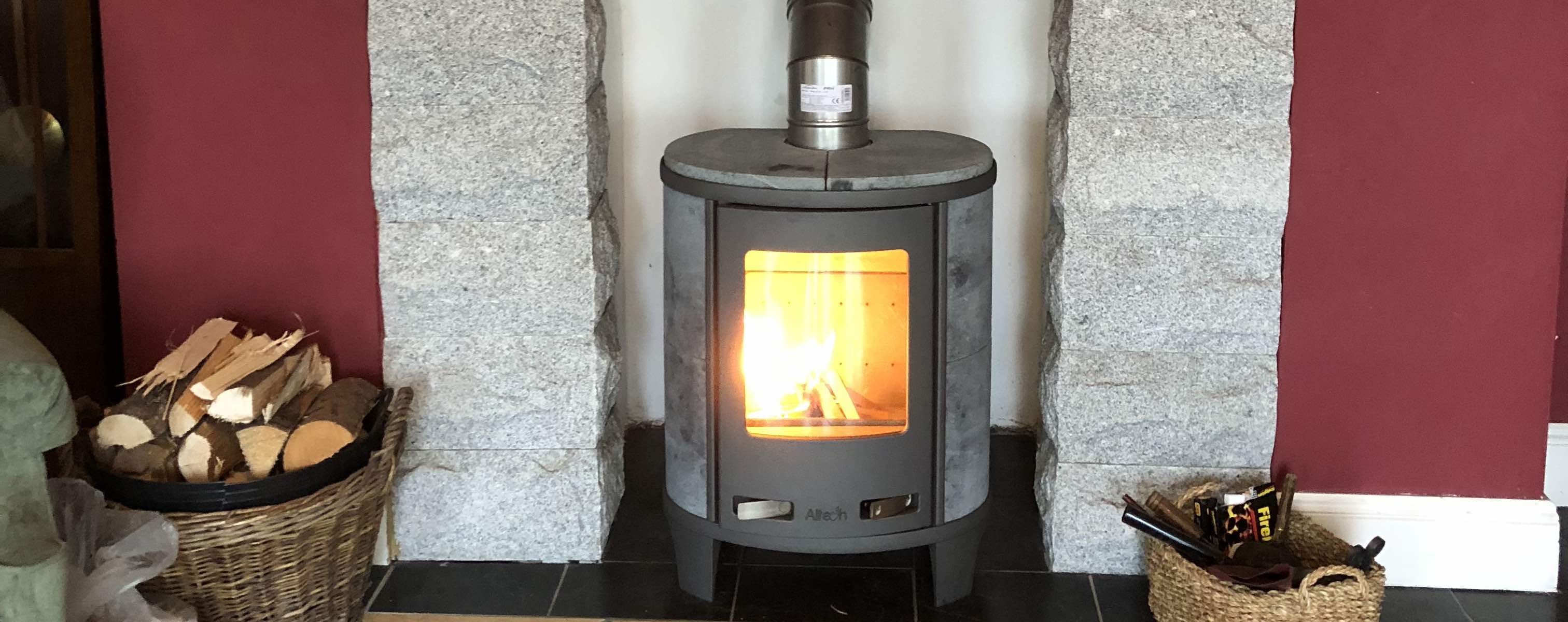
Radiant Heat
The heat storing capacity of soapstone is very high, the heat conduction fast and the radiant heat long lasting.
On Radiant Heat
(text provided by Tulikivi)
Hearth and Home
For 1.5 million years, we enjoyed the radiant heat of the ancient wood fire. We used rocks to secure the fire and as kitchen utilities. The cave people found heat from their fires stored in and slowly radiating from the cave walls. As our building knowledge grew, man figured out how to tame the fire and how to store its heat more and more effectively.
We abandoned caves in favor of houses with stone fireplaces. As winters set in, the fireplace became the center of every home, where we could eat and sleep after a hard day of hunting and gathering. Even today we crave the safety of hearth and home.
Central Heating:
About 50 years ago, we started to heat our homes and businesses more and more with forced hot air, the kind used with radiators and central air heating. Fireplaces were phased out, especially in the cities. Radiant heat became a cozy memory.
Forced-air heating uses the same principles used in a hot air balloon. We heat metal plates with hot water or electricity. These plates heat the air around them and this heated air is forced through the room so that air is heated and rising all the time. While this hot air might manage to keep us warm, it does little else.
To understand the implications of the transition from radiant heat to forced-air heat, we have to understand the effects of various kinds of heat on our bodies.
The Thermostat in Your Body
Man has dwelt in rather hot areas for most of our evolution. So our inner thermostat is focused on cooling down in order to keep our body temperature stable at around 96 degrees Fahrenheit.
When we digest the food we eat, we produce heat. so our body has to assure that this heat can be expelled. Most of this heat transfer happens through the skin, which has an average temperature of 86 degrees. If you’re too hot, the body pumps more warm blood to your skin, which turns red.
When this happens you actually radiate about the same amount of heat as a 100 Watt light bulb. The body also uses the cooler surrounding air, evaporation and breathing as other ways of cooling down. When traveling into colder areas, man found that there was little his body could do to help him keep warm. Cold causes blood to move away from hands and feet in order to reduce heat losses, which is why cold turns you blue. If the body remains cold it begins shivering, and teeth begin chattering. These muscle movements create heat. That’s why prehistoric man developed warm clothing and warmer shelter, and used fire to keep warm.
What is Radiant Heat?
Basking in the sun and sitting by your Tulikivi fireplace both help to keep your body warm in the same way. Scientists call it radiant heat. it’s a kind of light that you can’t see. It has nothing to do with radioactivity! Cats see it quite clearly and use it to catch mice in the dark.
Heat rays are also called infrared light, because their wavelength is somewhat longer than red light. Infrared light will heat up every object it falls upon. Heat rays from very hot objects can penetrate up to four centimeters deep into your body, though around one millimeter is quite enough. This is where about a quarter of your blood flows to distribute heat throughout your entire body. As long as the temperature of the heat source is higher than that of your skin, you experience a direct heat transfer. that’s why sitting near a Tulikivi feels so great when you are coming in from the cold.
With radiant heat, room air can be relatively cold (64- 68 degrees) because the deep-heating rays compensate. But the average heated room air doesn’t heat up your body in the same way. Your skin loses heat to warm air, albeit less than with cold air. Forced-air heating only helps create an environment, which is warm enough to keep your body warm through your own inner fire. If room air gets too warm, it may cause you to breath more quickly to remove heat, which may result in a restless, constricted feeling.
Conversely, cold radiation is rather unpleasant. Cold stored in walls and floors can keep you feeling colder. This syndrome is typical with forced-air heating systems, which heat up room walls only marginally. Even if the room air is rather warm, the cold radiation will cause the blood to withdraw from the skin.
Tulikivi Vibrates on Your Wavelength
The soapstone heat from our fireplaces vibrates at precisely the same wavelength of your body radiation, at 8-9 µm. Scientists say this explains a lot about the general appreciation for the quality of our heat, which we have recorded over the years. The wavelength of hot metal surfaces is much shorter. It feels aggressively hot when close by, but does not reach far.
Forced-air heating produces a vertical temperature difference of up to 50 degrees, producing a warm head and cold feet. Your body can’t adjust to that. The thermostat in an air heating system controls the air temperature at the level of the thermostat, while creating the illusion that a desired “room temperature” has been achieved. But to be really comfortable, the room would need to have height differences, as in a sauna.
With radiant heat, the heat difference is horizontal. So, by moving closer to or further from the heat source, both older people sensitive to cold and younger people can find an area in the same room where they feel comfortable.
